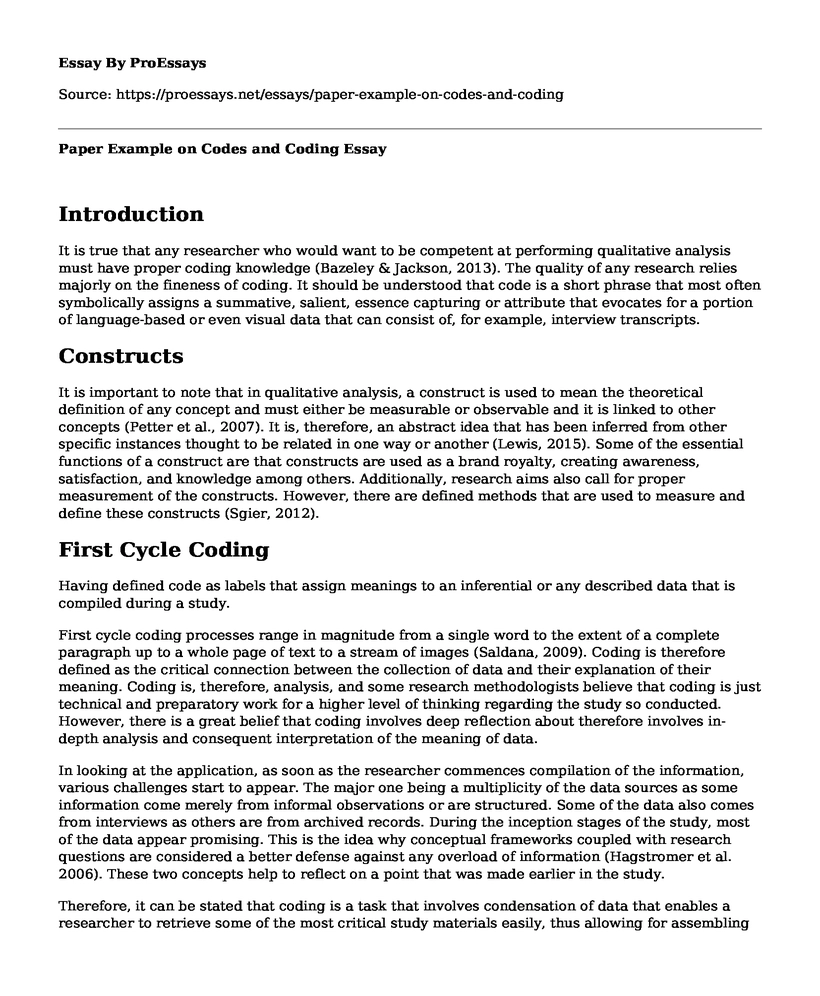Introduction
It is true that any researcher who would want to be competent at performing qualitative analysis must have proper coding knowledge (Bazeley & Jackson, 2013). The quality of any research relies majorly on the fineness of coding. It should be understood that code is a short phrase that most often symbolically assigns a summative, salient, essence capturing or attribute that evocates for a portion of language-based or even visual data that can consist of, for example, interview transcripts.
Constructs
It is important to note that in qualitative analysis, a construct is used to mean the theoretical definition of any concept and must either be measurable or observable and it is linked to other concepts (Petter et al., 2007). It is, therefore, an abstract idea that has been inferred from other specific instances thought to be related in one way or another (Lewis, 2015). Some of the essential functions of a construct are that constructs are used as a brand royalty, creating awareness, satisfaction, and knowledge among others. Additionally, research aims also call for proper measurement of the constructs. However, there are defined methods that are used to measure and define these constructs (Sgier, 2012).
First Cycle Coding
Having defined code as labels that assign meanings to an inferential or any described data that is compiled during a study.
First cycle coding processes range in magnitude from a single word to the extent of a complete paragraph up to a whole page of text to a stream of images (Saldana, 2009). Coding is therefore defined as the critical connection between the collection of data and their explanation of their meaning. Coding is, therefore, analysis, and some research methodologists believe that coding is just technical and preparatory work for a higher level of thinking regarding the study so conducted. However, there is a great belief that coding involves deep reflection about therefore involves in-depth analysis and consequent interpretation of the meaning of data.
In looking at the application, as soon as the researcher commences compilation of the information, various challenges start to appear. The major one being a multiplicity of the data sources as some information come merely from informal observations or are structured. Some of the data also comes from interviews as others are from archived records. During the inception stages of the study, most of the data appear promising. This is the idea why conceptual frameworks coupled with research questions are considered a better defense against any overload of information (Hagstromer et al. 2006). These two concepts help to reflect on a point that was made earlier in the study.
Therefore, it can be stated that coding is a task that involves condensation of data that enables a researcher to retrieve some of the most critical study materials easily, thus allowing for assembling of large amounts of data that are used together and to further put together the bulk information into readily and analyzable parts (Cooper, 2009).
Second Cycle Coding
From above, first cycled coding is merely a way to put together segments of data initially. In the second cycle of coding, there is pattern coding which is a way of grouping the already grouped summaries into smaller categories, constructs or themes (Saldana, 2015). Pattern codes are explanatory or inferential codes and help to identify any new theme, explanation or a configuration. These aspects help to pull together a large number of materials from the first cycle coding into more expressive and parsimonious analysis units. Pattern coding can perform the following functions:
- It helps to condense junks of data into smaller and functional units.
- Also helps the researcher to get into analysis during the process of data collection to enable focus later in the fieldwork.
- Additionally, in cases of multi-case studies, it lays the foundation for the close case analysis by surfacing directional processes and common themes.
Reference List
Bazeley, P., & Jackson, K. (Eds.). (2013). Qualitative data analysis with NVivo. Sage Publications Limited.
Cooper, R. (2009). Decoding coding via the coding manual for qualitative researchers by Johnny Saldana. The Qualitative Report, 14(4), 245-248.
Hagstromer, M., Oja, P., & Sjostrom, M. (2006). The International Physical Activity Questionnaire (IPAQ): study of concurrent and construct validity. Public health nutrition, 9(6), 755-762.
Lewis, S. (2015). Qualitative inquiry and research design: Choosing among five approaches. Health promotion practice, 16(4), 473-475.
Petter, S., Straub, D., & Rai, A. (2007). Specifying formative constructs in information systems research. MIS quarterly, 623-656.
Saldana, J. (2009). First cycle coding methods. The Coding Manual for Qualitative Researchers. Thousand Oaks, CA: Sage Publications Ltd, 45-145.
Sgier, L. (2012). Qualitative data analysis. An Initiative. Gebert Ruf Stift, 19-21.
Saldana, J. (2015). The coding manual for qualitative researchers. Sage.
Cite this page
Paper Example on Codes and Coding. (2022, Jul 29). Retrieved from https://proessays.net/essays/paper-example-on-codes-and-coding
If you are the original author of this essay and no longer wish to have it published on the ProEssays website, please click below to request its removal:
- Essay Sample: Hotel PCI Compliance
- Essay Sample on Network Security
- Successful Implementation of Health Information Technology: Reports, Methodologies & Lessons Learned
- Essay Example on Unity Platform: The Key to Real-Time Game Development
- English Changed by Internet & Social Media: A Global Transformation - Essay Sample
- Essay Example on Big Data: How to Measure and Improve Strategically?
- Research Paper on IoT Security Framework for Smart Home Devices: A Review







